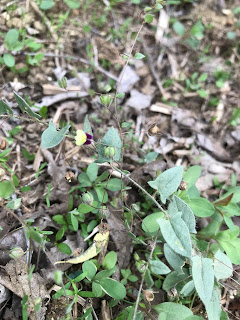However, it (and some of the vegetation around) hold a couple of rather good beetles, the leaf beetle Chrysomela saliceti and the histerid Saprinus virescens. For the chrysomelid I think it's its only known UK site.
Fellow moth-er and beetler, Bill had found a Saprinus during the week under some knotgrass - where they prey on the associated Gastrophysa polygoni, so I thought I should go and find my own.
I spent a good couple of hours poking about under all the knotgrass I could find but drew a blank. On leaving, I bumped into beetle expert and pan-species lister, Steve Lane who showed me one that he had found up the road in another field edge - untickable and in a pot but still nice to see.
Whilst there he took me through a hedge to the corner of another field where he'd found some good arable plants. All of which were new to me.
 |
| Dwarf Spurge Euphorbia exigua |
 |
| Round-leaved Fluellen Kickxia spuria |
 |
| Sharp-leaved Fluellen Kickxia elatine |
 |
Steve also mentioned a large manure heap back down the road that was heaving with Lesser Earwigs (cue a guffaw from the clued-up schoolboys) and the staph Astenus pulchellus.
Off I went and got sieving. Both species were easily seen and I also found the rather nice histerid, Atholus bimaculatus, which was a new one for me.


Your plant might be Pale Persicaria, though I've never seen it (or Redshank) with such bold leaf spots before. Might be doing something a bit weird if growing in heavily enriched soil, I guess?
ReplyDelete